|

With thanks to Diego Puls - NL for providing me
with those many editions and his further support.

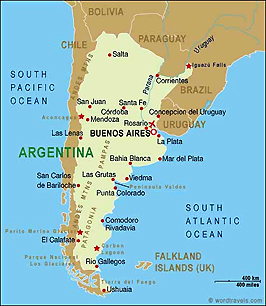
Before Parker Brothers/Hasbro marketed their games Argentine was already very familiar with
its proper monopoly-like game Estanciero.
As far as I know Parker's name appeared first in this country about 1985,soon
after which came a close cooperation with ToyCo, probably the biggest
games company in the country, also having the Estanciero editions it his
program.
(It turns out monopoly-like games of inland make to be in a
number of countries all over the world, mostly better known than the Parker
Brothers/Hasbro edition, also available since second half of the 20th century,
next to the inland versions. Except for Argentina the countries are:
| * Austria: Das Kaufmännische Talent DKT |
* Mexico: Turista |
| * Brasil: Banco Imobilíario |
* Norway: Millionær |
| * Denmark: Matador |
* Russia: Manager |
| * Hungary: Capitaly |
* Spain: El Palé) |
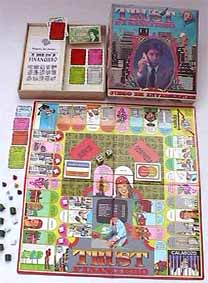 Edition:
TRUST Financiero - square box, Art.N° 6310 Edition:
TRUST Financiero - square box, Art.N° 6310
Juego de Inversiones (The game of investments)
Publisher: H Ruibal - ± 1980
Dimensions of the box: 25.5 x 26.0 cm
The game:
Considering the state in which this game was bought it must have been on the
shelfs of the (cigar) shop for years. That is why I assume this game to be
issued at least 20 years ago.
Trust Financiero is a common Monopoly game as well although it doesn't show the
Parker Bros./Hasbro red Monopoly bar. The
Rules of this game say: "The aim of this game is buying properties, earning
as much money as possible and playing the other players bankrupt". So
it is self-evident that it is compared with the "world-famous" game:
Similarities:
 |
There are 8 groups of properties, the colors of which however
differ from the Parker Bros./Hasbro issues. |
 |
Jail is Calabozo (Cell) on the game board,
however the cards say cárcel. It shows an unshaved rascal, properly bearing
a tie, behind 11 bars.
He is sent from the 4th corner. The 3rd
corner is Descanso (Rest). |
 |
One side of the propery deeds (54x71 mm) show the prices to be paid
for a visit, while the back side show the mortgage value. |
 |
The purchase prices of the properties start with US$ 60 (x1000) and
increase to 400 (x1000), while the stations cost 200 (x1000) and you receive 200 (x1000)
over Salida. |
 |
Two kinds of cards (50x70 mm) are called Suerte (Luck)
and Sorpresa
(Surprise) and are both situated along the 4th
side of the game board. |
 |
There are 6 banknotes, issued by the Trust Bank and provided with
pictures of artists as they occurred on the German banknotes of
the period 1958-1990 (what can the reason for this be?), viz. 1.000
- 5.000 - 10.000
- 50.000 - 100.000
and 500.000. The currency is US
Dólar. |
 |
The 6 colored, plastic tokens look like clowns caps. |
 |
Both dice are white with black pips. |
Differences:
 |
The name of the game isn't mentioned on the soft game board's
midfield. |
 |
The design of the spaces (long and narrow and the field's color in
half a circle on top) and the corner fields (large rectangulars) as
wel as the distribution over the board is obviously different.. Side 1 and 3
have 10 spaces each, side 2 has 11 situated around the businessman-behind
his-computer while side 4 only has 9. |
 |
Instead of 4 stations are 3 viñedos (vineyards)
and 1 Pozo petrolero (oilwell), of which only
2 are exactly in the mid of the side. |
 |
On the Electric Company space is Parque de la Ciudad (Amusement
park,
see http://usuarios.lycos.es/pciudad/home.htm)
and instead of Water Works is Ital Park (Funfair,
doesn't exsist any more) |
 |
The plastic houses with chimney are white, while the green
hotels are 2 floors high buildings. |
The properties in Trust Financiero are from Salida on always:
San Telmo - La Boca
- Viñedos Salteños - Zona de Flores
- Zona de Plaza de Mayo - Zona
de Plaza San Martín - Calabozo - Parque
Patricios - Parque Lezama - Parque
Chacabuco - Pozo petrolero Comodoro Rivadavia - Avenida
Corrientes - Calle Esmeralda - Calle
Florida - Descanso - Villa del Parque
- Caballito - Villa
Devoto - Viñedos Mendocinos - Avenida
Las Heras - Avenida Córdoba - Avenida
Santa Fe - Marche al calabozo - Botánico
- Palermo - Barrancas
de Belgrano - Viñedos Sanjuaninos - Avenida
Quintana and Avenida Libertador.
The price of this set amounted to ARS 22.- (€ 6.60) July 2002.
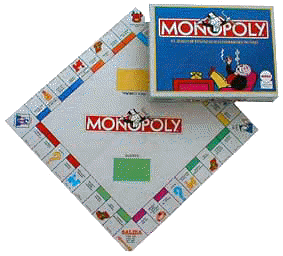 Edition: Standard,
No 90101 Edition: Standard,
No 90101
Publisher: Parker Bros./antex andina s.a. -
±1985
Dimensions of the box: 23.5 x 31.2 x 5.5 cm
The game:
On the one side this obviously is a Parker Brothers issue, however, the poor
finish shows that it is of "inland manufacture".
It is not only because of Rich Uncle Pennybags presence but also the streets
are those of the American version, so those of Atlantic City (see
chapter USA), translated into Spanish. It is remarkable that there is no mention
what so ever of patents underneath the red
bar in the centre of the game board.
The game is of soft cardboard folded twice, reason why it is
somewhat "comfortable" in the box. Its back has a pattern of the name antex®
printed. Folded it has the play side outwards.
The streets have the regular color bars, however in the strange order: green
- red - dark blue
- light brown - light
blue - yellow - dark
green and lila.
The property deeds (65x90 mm) with rounded corners have a red
back.
The Arca Comunal (Community Chest) spaces show a red
treasure chest.
The green Suerte(Luck)- and yellow Arca Comunal cards
have the same sizes (45x76 mm) and funny illustrations as of the American
version. The money consists of Monopoly banknotes with low denominations 1 -
5 - 10 -
20 - 50 -
100 and 500
as it corresponds with the low values of the properties. The currency is dollar. Over Salida
you receive $ 200. The white banknotes with color printing are made of strange
feeling glossy paper. The backside has a light blue
dots pattern.
The 8 tokens are but tiny, colored discs of diameter 14 mm. The plastic houses
are red, while it are the hotels who
are green. Both white dices are very
small (sides of 10 mm).
The price of this set amounted to ARS 2900 (€ 25.-) February 1997.
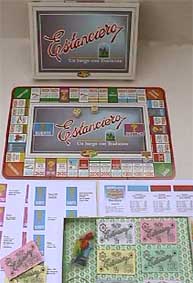 Edition:
Estanciero - small box, Código 137 Edition:
Estanciero - small box, Código 137
Un juego con tradición (A game with tradition)
Publisher: Lugano Toys S.R.L. - ± 2000
Dimensions of the box: 21.5 x 30.8 cm
The game:
An Estanciero is a rancher, who in this game has to try to collect
as many provinces as possible. Hence the frequently present logo of that rancher.
The presentation of this game is simple. The lid of the white box shows
the name of the game in a blue grey field with there under the logo of a rancher. The bottom of the box is unprinted.
The soft game board with rounded corners is folded into 3 parts
and measures 29.5 x 46 cm unfolded. The back parts show a green
pattern of the Lugano Toys logo. The 42 spaces are divided into zonas
(parts of provinces), campos (agricultural
enterprises),
ferrocarriles (railway companies), Compañías
(works) as well as the cards Suerte (Luck)
and Destino (Destination).
From Salida (not being the first corner) on
they are resp.:
Provincia Formosa:
Zona Sur - Zona Centro - Zona Norte
Impuesto a los réditos, pague 5000 (Income tax, pay 5000)
Provincia Río
Negro: Zona Sur - Zona Norte
Premio Ganadero, cobre 2500 (First price for best pedegree cattle,
receive 2500)
Compañía petrolera (Oilcompany)
Provincia Salta:
Zona Sur - Destino - Zona Centro - Ferrocarril General Belgrano
- Comisaría (Police station) - Zona Norte
Suerte
Bodega
Provincia Mendoza:
Zona Sur - Ferrocarril General S.Martín -
Zona Centro - Zona Norte
Descanso
Ferrocarril General B.Mitre
Provincia Santa Fe: Zona Sur -
Zona Centro - Destino - Zona Norte
Ferrocarril General Urquiza
Provincia Tucumán: Zona
Sur - Zona Norte
Estacionamento libre (Free parking)
Provincia Córdoba:
Zona Sur - Zona Centro - Ingenio (Sugar works) - Marche
preso (Go to Jail) - Zona Norte
Suerte
Provincia Bs.Aires: Zona Sur - Destino -
Zona Centro - Zona Norte
Impuesto a las Ventas (Purchase tax)
So it is clear this really is a Monopoly-like game with 8 groups of
"streets", however the distribution of properties and other spaces is
considerably upset:
 |
There are 4 stations indeed, however they are divided over the
first 3 sides. |
 |
The 2 groups of 2 properties are to be found on the 1st and 3rd
side. |
 |
While the Hasbro Monopoly game has 3x a Chance and 3x a Community Chest
space on the board this game has but 3 Destino and only 2 Suerte
spaces. |
 |
One can "rest" on the 3rd corner, however you can
Park Free again somewhat further on. |
 |
Instead of utilities Electric Company and Water Works here 3
companies Compañía petrolera, Bodega and Ingenio build 1 group. |
Some texts of Suerte- and Destino cards read:
-
Haga un paseo hasta la Bodega. Si pasa por la Salida cobre 5000. (Make
a trip to Bodega. If you pass Start you receive 5000)
-
Sus propiedades tienen que ser reparadas. Pague al Banco 500 por cada
chacra y 2500 por cada estancia. (Your properties must be
repaired. Pay your Bank 500 for each farm and 2500 for each ranch)
-
Error en los cálculos del Banco. Cobre 4000. (The Bank has
made an error in your favour. You receive 4000)
-
Gastos de Sanatorio. Pague 2000. (Sanatorium expenses. Pay 2000)
Both property cards and Suerte- and Destino cards are not well punched out
and must be loosened as yet. The small Estanciero-banknotes
(52x88 mm) look very carefully edited. They are one sided printed on color paper
and show except for the name Lugano Toys the rancher as well. The 8
denominations are: 10 (white) - 50
- 100 - 200
- 500 - 1000 (white) - 2000
and 5000. It is strange there is no
reference to a currency.
The green farms and blue
ranches are but tiny, round, plastic chips in a diameter of 12
mm.
The 6 tokens are colored, hollow pawns. Both large dice (with15 mm
sides) are ivory colored and have black pips.
The Rules are printed on the inside of the lid.
The price of this set amounted to ARS 20.- (€ 6.-) July 2002.
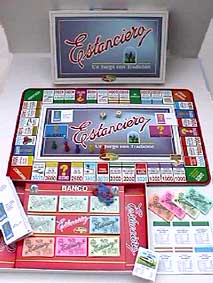 Edition:
Estanciero - large box, Código 138 Edition:
Estanciero - large box, Código 138
Un juego con tradición (A game with tradition)
Publisher: Lugano Toys S.R.L. - ± 2000
Dimensions of the box: 27.6 x 45.0 cm
The game:
This version of the proper Argentine Monopoly with 12 spaces
between corners on the long sides and 7 spaces on the short sides is
exactly according to the smaller edition Código 137 except for 3 differences.
However, these 3 differences are very striking:
-
The large game board of solid cardboard (43.3x67.7 cm) consists of 3
parts of a jigsaw-puzzle.
-
The insert of the innerbox is of red
cardboard and folded in such a way
that the trays serve for the accessories,
whereas the rise is ment
for the banker's banknotes. A player with
some experience however will
wonder how the stacks will remain neatly
together.
-
Although made of the same tiny, round, plastic chips of 12 mm diameter farms
are blue now and ranches red.
(This makes believe that
these chips are randomly distributed in various
colors over the games.)
The price of this set amounted to ARS 40.- (€ 12.-) July 2002.
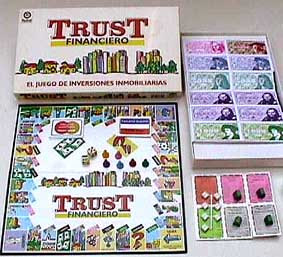 Edition:
TRUST Financiero - long little box, Art.N° 6310 (1) Edition:
TRUST Financiero - long little box, Art.N° 6310 (1)
El juego de inversiones inmobiliarias
(The
game of investments)
Publisher: Ruibal SRL. - ± 2000
Dimensions of the box: 21.1 x 36.0 cm
The game:
Despite he considerably changes the design of a game, Ruibal still applies the
same article number. This issue is much more modern and colorful than the one of
±1980. A pitty the solid board is made so small (43.7x35 cm).
Underneath the name in tall red characters (by
incident or does it have to look like the red
Monopoly bar?) on the white lid of the little box is a simple but colorful
sketch of houses and appartment buildings being the real estate that is at stake
in this game. If you count you will rapidly discover the 40 spaces are now
equally distributed over the sides. The illustrations on these spaces are much
smoother even abstract. The Jail is only marked by 3 rods with 2 hands, the Descanso (Rest)
corner shows a few flags (on a golf-link?).
The names and colors of the property deeds are the same indeed, however often
somewhat differently written. From Salida onwards they are now
called:
San Telmo - La Boca
- Viñedos de Salta - Plaza Flores
- Plaza de Mayo - Plaza San
Martín - Calabozo - Parque
Patricios - Parque Lezama - Parque
Chacabuco - Avenida
Corrientes - Calle Esmeralda - Calle
Florida - Descanso - Villa del Parque
- Pozo petrolero - Caballito - Villa
Devoto - Avenida Las Heras - Avenida
Córdoba - Viñedos
de Mendoza - Avenida
Santa Fe - Marche preso - Jardín
Botánico
- Palermo - Barrancas
de Belgrano - Viñedos de San Juan - Avenida
Quintana and Avenida Libertador.
The spaces "Pozo Petrolero" and "Viñedos de Mendoza" are
resp. moved 5 and 3 places forward.
For the rest the banknotes, cards, tokens and dice are still exactly the same as
those of the much older issue.
The bottom of the box is un-printed.
The price of this set amounted to ARS 34.- (€ 10.20) July 2002.
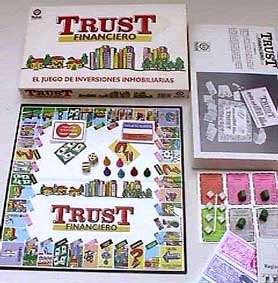 Edition:
TRUST Financiero - long little box, Art.N° 6310 (2) Edition:
TRUST Financiero - long little box, Art.N° 6310 (2)
El juego de inversiones inmobiliarias
(The
game of investments)
Publisher: Ruibal SRL. - ± 2000
Dimensions of the box: 21.1 x 36.0 cm
The game:
This issue is exactly the same as the one before with only one difference:
The bottom of the box now shows a short text and a black/white picture of
the game. This picture suggests the high hotels to be white, what is not
the case.
The price of this set amounted to 2002 ARS 20.- (€ 6.-) July 2002.
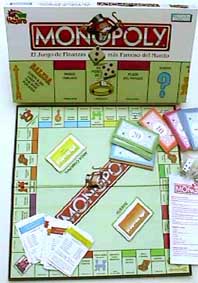 Edition: Standard
- long little box (1) Edition: Standard
- long little box (1)
Atlantic City - Spanish, Art.N° 00818
Publisher: Parker
Brothers/Hasbro/The Toy Comp. S.R.L. - 2000
Dimensions of the box: 21.7 x 41.5 cm
The game:
The lid of this long little box shows Mr.Monopoly out the middle O
of Monopoly in the red bar. Because Rich
Uncle Pennybags was not renamed into Mr.Monopoly (with red
bow tie) until 2000 this issue must date from that year as well.
Although this edition has been manufactured in Argentina it still is the Spanish
language issue of the American version, i.e. with the streets from Atlantic City.
Of this both most expensive streets next to Salida are shown on the lid
underneath the red bar. On the lid and all
its rims show the blue and white
logo of Parker Brothers, but in addition there is a green
and red Hasbro promotion sign indicating the
changeover from Parker to
Hasbro.
The bottom of the box show a color picture of a game board (with blue
back) and all accessories. Unfortunately this picture was made of an American
edition (entire English text) with a.o.things black locomotives and blue
treasure chest. Neither the banknotes and cards shown belong to this edition.
The game board of this set has a black back and its playside is
folded outwards. The properties are still low prised, reason why you receive but $ 200
over Salida. The property deeds (58x89
mm) with rounded corners have a blue
back.
The funny illustrated orange colored Suerte
(Luck) and yellow colored
Arca
Comunal (Community Chest) cards are rather small (45x77 mm).
The money consists of one sided printed Monopoly banknotes in low
denominations 1 -
5 - 10 -
20 - 50 -
100 and 500.
Here again the $-sign is used on the game board as well as on the property deeds
and in the Rules.
The 10 metal tokens are the very well-known: boat - car - hoat -
dog - iron - rider-on-horse - wheel-barrow - canon - thimble and shoe. However
it says on the bottom of the box that there are only 8 tokens supplied.
The green houses and red
hotels are made of transparant plastic. They have a chimney in the centre
of the roof.
Both dice are white with black pips. The Rules are printed red
on white paper.
The price of this set amounted to ARS 40.- (€ 12.-) July 2002.
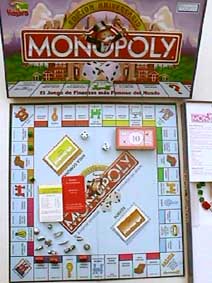 Edition:
Monopoly-Edición-Aniversario, Art.N° 00819 Edition:
Monopoly-Edición-Aniversario, Art.N° 00819
Publisher: Parker
Brothers/Hasbro/The Toy Comp. S.R.L. - 2000
Dimensions of the box: 25.2 x 48.3 cm
The game:
This is again a Spanish language issue of the American version, i.e. with the
streets of Atlantic City.
The same design is used for this anniversary edition as of the Deluxe
editions of many other countries in the same period:
 |
Along the lower side of the colorful lid is a part of the 3rd
side
of the
game board with the (green) locomotive in
the centre. In
contrast
to the Deluxe versions of other countries there are no gold colored tokens shown on the streets. |
 |
Right on top of the locomotive are 2 white dice showing 1 and 4
upwards. |
 |
On top of the dice is the red
Monopoly-bar-with-shadow and Mr.Monopoly out the central O. |
 |
And on top of that is finally a gold colored bow stating this is an
anniversary issue. |
However, in contrast to Deluxe editions this box is not so high as to contain
a banker's carousel card holder.
The bottom side of the box shows a nice color picture of the board and the
accessories, however without tokens. Because this is an anniversary
edition a "moneybag" has been added to the metal tokens.
The property deeds, Suerte and Arca Comunal cards, banknotes, houses
and hotels, dice and Rules are
exactly the same as those of the standard edition Art.N° 00818.
This edition is also exported to Chile and Peru.
The price of this set amounted to ARS 46.- (€ 13.80) July 2002.
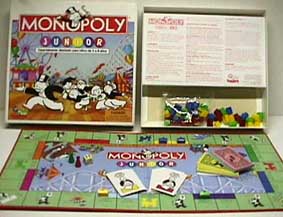 Edition: Monopoly Junior, Art.Nº 441
(1) Edition: Monopoly Junior, Art.Nº 441
(1)
Publisher: Parker
Brothers/Tonka/Hasbro
Argentina S.A. - ±2000
Dimensions of the box: 30.3 x 30.3 cm
The game:
The finish of this Junior game is according to the American design, i.e.
a somewhat oblong game board in a square box. It also bears the "typical"
American ref.number 441. However it is Fabricado en Argentina indeed.
On the long sides are 10 spaces and so there remain only 6 for the short sides.
Moreover the sizes of the spaces vary. The backside of the 1x folded game
board is red. The bottom of the box
shows a color picture of the board with all accessories.
In the innerbox is a cardboard insert showing the Rules in red.
Join Rich Uncle Pennybags and his nieces and nephews for a thrill-filled day at
the "street of amusements", the Roller Coaster, the Magic Show, the
Water Slide, the Video Arcade and more.
Four children can play at the same time, because there are 4 simple pawns
(instead of cars as the picture on the bottom suggests), respectively yellow, red,
blue and green.
The Casitas de Venta (ticket booths) that have to
be distributed amongst the players have the same 4 colors. They look very much like the well-known houses and even
have a chimney. The moment you own 2 entretenimientos (attractions)
of the same color one have to pay double the amount shown on the space.
There are 6 Suerte spaces where cards can be drawn with instructions like
Dirigirse al tobogan de agua (Go to the Water Chute)
and Paga
$3 para tomar el tren para ir al toilette (Pay $3 to take the
train to the Rest Room). The
dimensions of these tickets are 45x78 mm.
The money
consists of 5 one side printed notes (51x83 mm) with Uncle Pennybags in various
situations the centrefield. The denominations are resp.: 1 - 2
- 3 - 4
and 5 $.
The die is white with black pips.
This edition is also exported to Chile and Peru.
The price of this set amounted to ARS 28.50 (€ 8.55) July 2002.
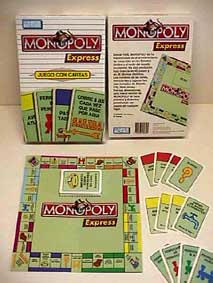 Edition: Monopoly Express, Art.N° 9035 Edition: Monopoly Express, Art.N° 9035
Juego de Cartas
(Card game)
Publisher: Parker
Brothers/Tonka/Hasbro
Argentina S.A. - 2000
Dimensions of the box: 19.0 x 27.2 cm
The game:
Strang enough there are no Rules supplied with this game, made in
Argentina. On the other hand it is manifest it is a happy families game,
because the aim is to make monopolies of one of the famous streets plus
1 or 2 adjacent other fields like Suerte, Arca Comunal, Obras de aguas
corrientes or Compañía de Electricidad. All 4 stations also make a
monopoly, as well as the the 4 corners. The game is again the Spanish language
version of the American town Atlantic City.
A colored bar along the edge of the little game board (26x26 cm)
indicates which 4 spaces belongs to a monopoly.
The Rules of the corresponding American Express
Monopoly Card Game, No.40155 from 1994 tell us:
"At the start of the game for a maximum of 4 players each one gets 4 cards;
the remainder is placed in the center of the game board (on the Pozo space).
The one who is on turn draw as many cards as necessary to bring his hand up to a
total of 5. Next he/she plays one card to the space of the matching property
group on the board. The one who adds the fourth card to 1 color makes monopoly
and put these cards face down in front of him/her.
There is no money, nor houses and hotels, but the
monopolies do have a value in points, increasing from 1 to 8. At the end
of each round each player's number of points are counted. The first player to
reach 50 points, or have the highest score after the final round has been
completed, is the winner ."
This edition is also exported to Chile and Peru. The price of
this set amounted to ARS 12.- (€ 3.60) July 2002.
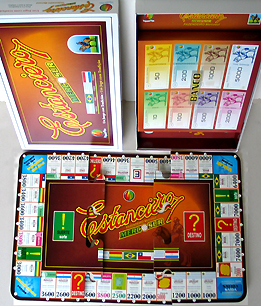 Edition:
Estanciero -
Mercosur - Código 8001390 Edition:
Estanciero -
Mercosur - Código 8001390
Un
juego con tradición (A
game with tradition)
Um jogo com tradição
Publisher: Lugano Toys S.R.L. - ± 2001
Dimensions of the box: 30.5 x 49.0 x
5.6 cm
The game:
This probably is the first bilingual
edition of Estanciero,
namely next to Spanish Portugese as well, suspected for sale in
the Argentina surrounding countries, as they occur on the board, ie Uruguay -
Paraguay - Bolivia - Chile and Brazil.
The breakdown of the fields varies by country and is very divers, including
agricultural and live-stock farms, factories, tourism, hotels, mining and
automotive industry.
From Salida/Saída
first corner, without number) the fields are resp.:
Uruguay:
Colonia Suiza/Tambo (1) - Salto/Elaboradora
citricos (2)(Citrus grower) - Punta
del Este/Cadena de hoteles (3)(Chain
of hotels) -
Impuestos/Impostos, pague 5000 (4)(Income
tax, pay 5000) - Montevideo/Banco
de inversión (5)
Paraguay: Concepción/Algodonales
(6)(Katoen)
- Intere$e$/Juro$, cobre 2500 (7)(Interests,
you receive 2500) - Cdad.del Este/Parque Industrial (8) - Villarica/Aceitera de soja (9)(Soybean
oil factory) - Destino (10) - Fortín Corrales/Campos
Ganaderos (11) (Livestock farms) - Encarnación/Ruinas
Jesuíticas (12)(Jesuit ruins)
Vacaciones/Férias (13)
Bolivia:
Chapare/Bananales (14)(Bananas)
- Suerte (15) - Oruro/Minas
de estaño (16)(Tin
mines)
- Beni/Campos para agricultura (17)(For agricultural areas) - Lago Titicaca/Ruinas
Incaicas (18) (Inca ruins) - Sta.Cruz
de la Sierra/Cia. exportado de gas(19)(Gasexport
companies)
Chile:
Puerto Montt/Compañia pesquera
(20)(Fishing
companies)
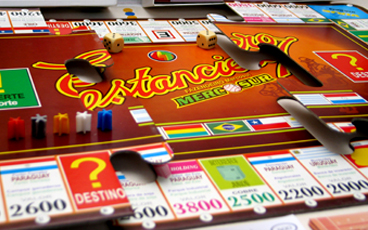 Fin de semana/Fim de semana (21) Fin de semana/Fim de semana (21)
Viña del Mar/Compañia de turismo
(22)(Tourist
companies)
- Concepción/Empresa forestal (23) (Forestry
company) - Curicó/ Exportadora
de frutas (24)(Fruit exporter)
- Destino (25)
Argentina:
S.C.de Bariloche/Pistas de sky (27) -
Libre estacionamiento (28)(Free
parking) - Santa
Fe/ Campos para agricultura y ganaderia (29)(areas
for agriculture and livestock) - Buenos Aires/Centro comercial (30) - Santa Cruz/Compañia petrolera (31) - Córdoba/Compañia Alimenticia y agroindustrial (32)(Food
and agro-industrial enterprises)
Brasil: Amazonia/Explotación
maderera (33)(Timber
harvest)
Viaje/Viagem (34)(Travelling)
Minas Gerais/mineria del hierro (35)(Iron mines)
- Suerte
(36) - Rio de Janeiro/Cadena de hoteles (37)(Hotel
chains)
- Destino (38) - Belo Horizonte/Industria automotriz
(39) (Automotive industry) - San Pablo/Industria
siderúrca (40)(Iron and steel industry) and Impuestos
(41)(Taxes).
Like the Cod.137 edition the innerbox has been filled with an insert of
thin cardboard folded such a way that a raised centerpiece has been created for
the banknotes of the banker and a tray on each side for the attibutes, as
tokens, dice and little discs of the farms and
ranches.
The property deeds as well as
the Suerte- and Destino-cards are not fully punched out, so they still should be
unplugged. The large Estanciero-banknotes
(65x155 mm) look very smart. They are two sided printed in color on white paper
and show except for the name Lugano Toys of course also the rancher.
The 8 denominations are: 10 - 50
- 100 - 200
- 500 -
1000 - 2000
and 5000. Strangely enough no indication is given about the currency.
The yellow
Chacras (houses)
and blue
(ranches)
are but round, plastic discs with a diam. of
12 mm
.
The 6 tokens are colored plastic, hollow pawns.
Both big dice (with sides of 15 mm) are ivory and have black pips.
Thee Rules are no
longer printed on the inside
of the lid, but added to the game as a loose sheet, one side printed
in Spanish in black, the other side in Portuguese
in red.
The price of this game was in March 2003 ARS 45.- (€ 13.45).
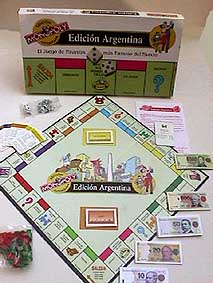 Edition:
Edición-Argentina, Art.N° 0820 Edition:
Edición-Argentina, Art.N° 0820
Publisher:Hasbro/Tonka/The Toy Comp. S.R.L. -
2001
Dimensions of the box: 25.2 x 48.3 x 4.2 cm
The game:
Oddly enough this is the first entire Argentine edition from Hasbro
according to the USAOPOLY design (see at USA), i.a. without the red
Monoply bar on the centre field of the game board, but a black one
instead with in that "Edición
Argentina" and an illustration on top. The lid shows the "yellow
sticker with red Monopoly bar with Mr.Monopoly",
to proof this is a Hasbro authorized edition. The lower part shows the Salida
space together with the 4 last spaces of the 4th side. The bottom
side of the box shows as usual with USAOPOLY design a color picture of the
game board with all its accessories. However it suggests the board's back side
to be red.
The properties in this edition are not streets from the capital
city, but landmarks from all over the country.
The properties of Edición
Argentina are from Salida
onwards.:
Ushuaia (worlds most
southern city, on Land of Fire) - Glaciar
Perito Moreno (impressive glacier in the south part
of the ) - Ferrocarril Roca - Península
de Valdez (peninsula in Patagonia,
where whales can be seen) - Esquel (winter
sports resort
in Patagonia) - Lago
Nahuel Huapi (splendid lake in the lake area of
Patagonia) - Cárcel/Sólo Visitas - Cerro
Tronador (mountain in the south part of the Andes, 3556 m) - Energía Eléctrica - San
Martín de los Andes (capital of the ecotourisme
in Patagonia) - Valle de las Leñas
(mundane ski area)
- Ferrocarril Mitre - Puente
del Inca ("incabridge", remarkable rocks
formation in the Andes) - Aconcagua (highest
mountain of entire America, 6958 m) - Cosquín
(well-known for its yearly national folklore festival) - Libre
Estacionamiento - Villa Carlos Paz
(scenic village in the Córdoba mountains) - Termas de
Río Hondo
(hot water springs) - Valle
de la Luna ("moonvalley", remarkable
landscape in the Andes reminding of the moon) - Ferrocarril Belgrano - Tren
de las Nubes(special train in the Salta mountains)
- Quebrada de Humahuaca
(picturesque Andes crevice in N-Argentina)
- Aguas Corrientes (running water) - Cataratas del Iguazú
(world famous waterfalls at the Brazilian border)
- Vaya a la cárcel - Gualeguaychú
(renowned for its carnivals) - Rosario
(2nd city in Argentina, 1 million inhabitants) - Mar del Plata (mundane
seaside resort)
- Ferrocarril
San Martín - La Boca (touristic
Italian district of Buenos Aires) and Obelisco ("Argentina's
navel", is in Buenos Aires).
Features of this Parker Brothers/Hasbro issue manufactured in Argentina:
 |
The colorbars of the properties fully differ from the "official"
issues in other countries. |
 |
The Parker-locomotives are not black but successively light
blue
- red - green
and light brown. |
 |
Behind the Jail's bars is ..... Mr.Monopoly. |
 |
The red car on Free Parking has a yellow
rear window and grey
tyres. |
 |
The usually blue treasure chest is red
now and the money bags are green. |
In folded state the dark
blue
back of the solid board is turned outwards. The values of the properties have
raised by a factor 10 with regard to 1985 and so you receive $ 2000 over Salida.
The orange colored Suerte
(Luck) and the yellow
colored Casa de la Moneda (the Mint) cards are
still very small.
The beautiful many colored banknotes (52x115 mm) with portraits of
statesmen and generals look very much the present-days official banknotes but
the pictures do not correspond to the denominations. In addition the back sides
are unprinted. The space where the official banknotes show "Banco
Central de la República Argentina" the notes of this game says
"Monopoly edición Argentina". The 7 denominations in Pesos are
resp.
10 - 20 - 50 -100 - 500 - 1000 and 5000. The prices of the properties on the
board are specified by a $-sign.
The 9 metal tokens are those so well-known : boat - car - hat -
dog - iron - rider-on-horse - wheel-barrow - canon and shoe. The bottom of the
box says only 8 tokens will go with the game inclusive the locomotive. However,
it isn't present.
The green houses and red
hotels are made of translucent plastic. They have a chimney situated in the
mid of the roof.
Both dice are white with black pips. The Rules are printed in red on
white paper.
The price of this set amounted to ARS 36.90 (€ 11.10) July 2002.
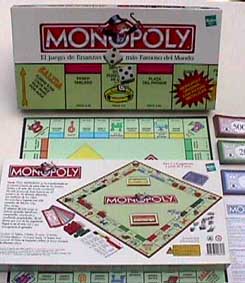 Editon:
Standard
- long little box (2) Editon:
Standard
- long little box (2)
Atlantic City - Spanish, Art.N° 00818
Publisher: Parker Brothers/Hasbro/The Toy Comp. S.R.L. - 2001
Dimensions of the box: 21.7 x 41.5 cm
The game:
The most striking differences between this issue and the earlier mentioned one
under the same Art.N° are:
 |
Both on the lid as on all 4 rims the Parker
Brothers logo has een replaced by the Hasbro logo. |
 |
On the lower right corner of the lid is a special mention saying "Original Monopoly with metal tokens", which remark is most
probably ment for Chile and Peru, because these tokens came
already with earlier issues. |
Other differences are:
 |
Although the color picture on the bottom of the box now do show the
right Argentine Spanish game it unfortunately shows a
red
back. In reality the board's back is dark blue. |
 |
The banknotes shown are the right ones, however the set goes with
10 tokens instead of but 8 as the picture shows. |
 |
The Rules are printed in blue
on white paper. |
For the rest this edition is exactly the same as the earlier issue.
This edition is also exported to Chile and Peru.
The price of this set amounted to ARS 40.- (€ 12.-) July 2002.
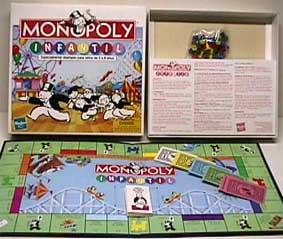 Edition: Monopoly Infantil, Art.Nº 441
(2) Edition: Monopoly Infantil, Art.Nº 441
(2)
(Children's
Monopoly)
Publisher: Hasbro Arg. S.A./The Toy
Comp.S.R.L. - 2001
Dimensions of the box: 30.3 x 30.3 cm
The game:
The great difference between this edition and the somewhat older version under
the same Art.N°441 is the translation of Junior into Infantil.
Although it doesn't like very obvious there are still some small differences,
viz.:
 |
The board's back is dark blue. |
 |
Also here the tokens are no cars but simple pawns-with-big-base. |
 |
The ticket booths are now small, plastic houses with chimney. |
 |
The one die only measures10x10x10 mm. |
Of course the Rules are the same.
This edition is manufactured in Argentina and is also exported to Chile
and Peru.
The price of this set amounted to ARS 28.50 (€ 8.55) July 2002.
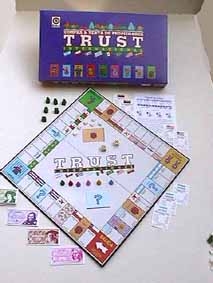 Edition:
TRUST Internacional, Art. 7030 Edition:
TRUST Internacional, Art. 7030
Compra & Venta de Propiedades (Buy and sale of real
estate)
Publisher: Ruibal SRL. - ± 2001
Dimensions of the box: 24.5 x 46.0 x 6.0 cm
The game:
The (unnecessarilly) large box for this international edition suggests a
luxury
finish. Although the game board is somewhat larger than those of the "long
little white boxes", because of which it is earsier to play on, the
presentation is still a bit poor.
Instead of landmarks from all over the country this version of Trust now has
landmarks from all over North-, Middle- and South America.
On the game board with black back the cities of the countries
are well state by their national flags.
From Salida
on they are resp.:
Side 1:
Chile: Valparaíso (picturesque
port) - Viña del Mar (mundane seaside resort)
LAN CHILE líneas aéreas
Cuba: Guantánamo - Camagüey - La Habana
Carcel
Side 2:
Brasil: Porto Alegre - Centro
Americana Agencia de Viajes (travel agency) - Rio de Janeiro - Florianópolis
PLUNA líneas aéreas (Uruguayan air line)
México: Jalisco -
Guadalajara - Acapulco
Descanso
Side 3:
Venezuela:
Caracas - Isla Margarita - Aruba (so this Dutch island is
confiscated herewith)
VARIG líneas aéreas(Brazilian air line)
Estados Unidos
(United States): La Florida - Orlando - Miami
Marche preso
Side 4:
Argentina: Villa Carlos Paz
(picturesque village in the mointains of) - Mar del
Plata (mundane seaside resort)
Bariloche (winter sports resort in the Andes)
AEROLINEAS ARGENTINAS líneas aéreas
Uruguay: San Ignacio - Punta del Este.
In Cárcel is again a man in spruce suit and with red
tie, this time behind 8 bars. He has been sent here by 2 policemen-with-cudgel
on the Marche Preso corner.
The Descanso corner shows a golf
player, apparently the symbol for "rest".
The bottom of the box shows a short text as well as a black/white
picture of the game with all its parts. The Suerte cards (50x70 mm)
have a light blue back with a dark
blue
?, while the Sorpresa cards have a beige
back showing a red parcel-with-ribbon. All
other game parts like the money, tokens, dice, houses and hotels are exactly the
same as those of the earlier mentioned editions.
The promotion price of this set was in a supermarket ARS 27.95 (€ 8.40) July 2002.
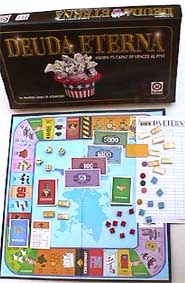 Edition:
Deuda Eterna (Eternal (foreign) debt), Art. 7400 Edition:
Deuda Eterna (Eternal (foreign) debt), Art. 7400
¿Quién es capaz de vencer al FMI?
(Who will be able to defeat the IMF?)
Publisher: Ruibal SRL - ± 2001
Dimensions of the box: 24.5 x 46.1 x 6.0 cm
The game:
This game of inland manufacture is a parody on the hard economic situation of
the country. Really a very interesting variant of
Prof.Ralph Anspach's Anti-Monopoly (see a.o. at Peru!)
The Rules describe the aim to be:
"To utilize the raw materials of Latin-America by industrilizing and to
export to
the large markets in the North. Therefore players have to become
entrepreneurs who have to solve the problems caused by the game. The capital
with all it stands for is provided by the
IMF, inclusive all its consequences: imposing conditions, devaluations, etc. The
aim is to overcome the problems and not making use of the IMF."
The game board is divided in a north and south part (see both black
spaces on the boards fold). In the north are a dozen industries of the
higher developed countries as well as the IMF who administers the capital. In
the south is Latin-America with its raw materials exporting products
without
added value like iron, copper, corn, cattle, etc.
Because this game rather differs from the Parker/Hasbro Monopoly I hereunder
give an enumeration of the play parts of this game:
 |
18 (plastic) stock gold bars with number R-18K. |
 |
a number of note sheets. |
 |
12 property deeds with blue
back and 3 $-signs. It strikes that there is no talk of mortgage. Each
property has 2 columns with rent prices for resp. buildings with national or
international industries. |
 |
21 green (Solidarity)
cards with on their back sides "2 hands together". |
 |
17 red brown Condiciones (Conditions)
cards with on their back sides a kind of Mr.Monopoly having dollar signs in
his eyes. |
 |
36 red houses for national industries. |
 |
36 somewhat larger blue houses for the big multinational
industries. |
 |
1 yellow
plastic piece (35x60 mm) that have to serve as Barrera Proteccionista
(Protectionism Barrier). |
 |
The simple banknotes one-sided printed on white paper. The currency
is U$S, the Argentine notation for American dollar. The 5
denominations are resp.: 50
- 100 - 500
- 1000 and 5000. |
 |
4 dice (with sides of 14 mm) ivory colored with black
pips. |
As usual with Ruibal all cards and even the banknotes are in sheats in the
box. So they have to be separated before use.
This game can be played by 3 to 6 players of which one can also be banker, who
in this case is the IMF manager. At the start of the game each player receive 3
(stock) gold bars and in order to know how much money everybody have to receive
he thows a die and gets $1,000 for each point thrown.
Startingpoint is the black space Latinoamérica. Each property
card applies for both areas.
When a player lands on one of the southern spaces he can choose between 2
possibilities:
-
He may receive from the IMF the raw material's value indicated on the
space, or
-
He pays the IMF that amount and processes the raw material.
In the northern part are the multinationals who make products starting
from the basis products from Latin-America. For example: Candies made from sugar:
|
Raw material |
Final product |
Color of the space |
|
Sugar
Oranges
Coffee
|
Candies
Jam
Instant coffe
|
Orange
|
|
Cotton
Tobacco
Weat
|
Clothing
Cigarettes
Cookies
|
Green
|
|
Fishery
Cattle
|
Preserves
Shoes
|
Sky blue
|
|
Copper
Tin
Iron
|
Cables
Electronics
Machines
|
Lilac
|
|
Crude oil
|
Fuel
|
Yellow
|
Each time a player lands on a space of the North the IMF has to pay
him the amount mentioned at the field's foot. This situation changes as the
Latin-American players built multinational industries in the North.
The
National Industries:
-
The owner of a raw material property can start producing by investing in "National
Industry" buildings. The price is given on the property deeds (f.e. for
Azúcar $150 for the first industry).
-
The moment the owner of a national industry lands on the corresponding
field of the North he has nothing to pay "taking the view that he who
has sugar shouldn't buy candies abroad".
-
Each moment a player lands on a national industry that belongs to someone
else he must pay the owner the amount given on the space (f.e. for Azúcar $100).
The Multinational Industries:
-
The player that owns a national industry (f.e. Azúcar) can extend his
industry in the North as a (so: Caramelo). For that he has to pay the
IMF the price of the first multinational (= $300) shown on the corresponding
property card (Azúcar) he already possesses.
-
As from this moment the owner receives from the IMF the amount mentioned
on the board (in this case $200) each time he lands on the field Caramelo.
-
However, in case another player lands on a space with established
multinationals he shouldn't pay the IMF but the owner of the industry the
amount given on the field.
Three industries may be built on each property but always the national
industry first before the multinational industry is on turn.
The owner of industries receives from other players double or treble the amount
shown on the concerning space depending on 2 or 3 industries being on the
property.
The owner also receives double or treble from the IMF if he lands on his own
multinational. The 3 stock gold bars each player has cannot be exchanged for a
fixed amount. They can be used to do payments in case:
-
player lands on a multinational or on a space still available in the North.
-
player lands on the FMI field, where he has to pay the rent of this turn.
However, the gold stocks cannot be used:
-
in case of flight of capital, coup d'états or to discontinue the
Protectionism Barrier.
-
to pay off the capital amount of a debt (only the rent may be paid with it).
-
to obtain a monopoly.
-
to pay the costs related to the condition of a "Condiciones"
card.
Crude oil doesn't built a chain with other products.
An industrial production chain arises when a player possesses all raw
materials belonging to the deeds of one color.
In contrast to the so well-known property trading game each player landing on
one of the built spaces of a chain must pay the total amount
corresponding to the number of buildings on these southern spaces.
Monopoly:
Players have to decide if they accept the "monopoly principle" before
starting the game. This means a player can buy the properties (with everything
built on) from another player, even if the latter don't like it. The IMF agrees
to this but a tax of $ 2,000 have immediately to be paid. A monopoly can only be
raised in the South and above that monopolies can change owner again and again.
The debts:
In order to realize all purchases and payments of monopolies players can
contract loans with the IMF. The amount of a loan is $ 1,000 at the minimum.
The interest is 10% per year (which corresponds with one full tour of the game
board), player has to pay when he passes the FMI-field. A player who wants
to pay the interest of his debt can use a spare gold bar for this purpose.
The one who is the IMF notes down each player's debt in the noteblock added.
The devaluations:
When a player has built up a debt of $ 10,000 he must go to the FMI-field
to re-negociate his debt. He must pay the interest of the turn and the IMF will
devalue the currency.
Because of the devaluation players currency is worth less. Devaluation means the
player from now on has to play with 3 dice, which means he moves much
faster so he has to pay more frequent.
In case player succeed in reducing his debt in a next turn down under $ 10,000
he strengthens his currency and so he is allowed to play with 2 dice again. The
IMF will cause a second devaluation the moment a player's debt reaches $
20,000. He calls the player in crisis again to negociate about his debt.
He/she has to settle the concerning interest and play with 4 dice from
that moment on.
The highest debt one can run up is $ 30,000. When a player reaches this
amount he/she won't get a loan anymore and the economic
embargo begins for him/her.
The economic embargo:
When a player has a debt of $ 30,000, but still has some cash he may continue
playing. However, when he lands on a space where he has to pay the IMF or
another player and his money is not sufficient the economic embargo begins
for him.
In order to obtain the necessary money the player under embargo places a (whole)
property, with or without buildings, at IMF's disposal. The IMF put this
property up for auction amongst the other players, at which a bid may not be
under 50% of the investment.
The player with the highest bid continues with this property and hands the money
over to the previous owner. In case no bid is done the property goes to the IMF
who pays 50% of the investment. The player under embargo must continue paying
interest with each turn as well as throwing 4 dice, until his debt has fallen
under
$ 20,000.
The moment the player in troubles has no properties anymore he finally has to
hand the rest of his money over and he will be declared bankrupt.
Treaty between players:
The players begin alone but they can unite in course of the play in order to
devellop a strategy against the IMF. To enter such a treaty a player must
land on the field Latinoamérica
after which all players are entitled to enter into any kind of treaty.
The moment a player lands on Latinoamérica he may invite other players to play
together or with three. The other players on their turn can unite as well. It
is forbidden to build industrial chains to share its benefits with 2 or 3
players if no pairs or trios have been formed in advance.
Those who decide to continue to play together or with 3 have to stay on the
Latinoamérica space and continue to play from there on, however eachone have to
pay off the interest of his debts to the IMF.
Pairs and trios:
If 2 or 3 players form a pair or a trio their money, reserves and industries are
combined to one community, however, each of them has to continue with his own
token and debts. In case the pair or trio build 1 or more industrial chains they
get the revenues.
Eachone must pay the interest of his own debts, however, the money now comes
from the same pool and since their properties are together the pair or trio now
decides together whether paying will be done with cash or reserve gold, like
they have to decide together whether who takes a new debt, taking into account
the limits valid for the devaluations and the limit to pass into embargo.
The members of the pair or trio throw the same way as any player with 3 or 4
dice in correspondance with the devaluations. As soon as one of them has built
up a debt of over $30,000 he may continue playing without the need to put a
property up for auction, however, he is not allowed to make new debts. Auctions
begin the moment all members of a pair or trio have reached the embargo limit.
End of the play:
At tie:
In case a player alone or a pair or trio succeeds in possessing more than half
of Latin-America, viz. at least 7 grounds each built with at least 2 national
industries and 2 multinationals
in the North he equals the IMF for economic strength and so he can retire in
full credit to enjoy his luck without the need to take outstanding debts into
account .
The winning businessman:
In case a player alone or a pair or trio succeeds in industrializing all 12
grounds of the South and at least 1 multinational on each ground in the North he
so shows his capability as entrepreneur. The IMF did not succeed in bleeding him
dry and so he deserves applause of all players.
The winning KO. (Knock Out?):
In case a player alone or a pair or trio possess all 12 grounds of the South
with 3 national industries each as well as the 3 corresponding multinationals he
is considered to be the "Great Champion" who is allowed to turn the IMF
his back.
It is also possible the players, alone or united go bankrupt or the IMF seize
all their properties and so everybody loses.
The price of this set amounted to ARS 35.49 (€ 10.80) July 2002.
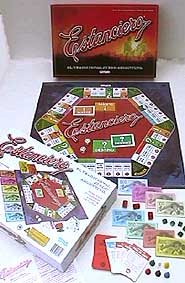 Edition:
Estanciero, Art.N° 9554 Edition:
Estanciero, Art.N° 9554
El tradicional juego Argentino (The traditional
Argentine game)
Publisher: ToyCo - ± 2000
Dimensions of the box: 27.0 x 40.5 x 6.8 cm
The game:
This luxury edition of inland manufacture is obviously from another maker and
apparently the same who also manufacture the games for Parker/Hasbro (see
further). The nice, red lid now shows
a picture of the rancher even a portrait of the man, as it also appears
on the banknotes.
Like with the Parker/Hasbro Monopoly game of any country the spaces remain the
same, despite the design. However, the distribution over the board differs with
this nice edition from the earlier described games. On the 6-sided double
folded game board of solid cardboard the numbered spaces are divided
equally such that they "do not go around the corner". The
Destino field is green
and is again situated next to Salida. The Suerte field is yellow
brown.
The dark background of the play side have pictures on the corners showing scenes
as they may occur on a rancher's estate:
-
the estanciero
-
a big threshing-machine in a grain field
-
a rearing horse
-
a milking woman farmer
On the special spaces in this issue are pictures of:
 |
a heavy, red brown steam engine on
each of the 4 stations. |
 |
an oil pump on space 8 of Compañía petrolera . |
 |
grape bunches on field 16 of Bodega. |
 |
a sugar mountain with a worker in a cane sugar plantation on field 31 of Ingenio. |
The bottom of the box shows a nice color picture of the board, the banknotes
and the other accessories. Maybe influenced by Parker/Hasbro?
The property deeds (58x90 mm) have rounded corners. The mortgage side is red.
The little Estanciero
banknotes (48x88 mm) are even smaller than those of other editions and
give the impression they are copies of official banknotes. However all notes
have the same portrait. Except for the name ToyCo the notes also mention
being issued by
"Banco Estanciero Central". The 8 denominations without currency
are resp. 10
- 50
- 100 - 200
- 500 - 1000 - 2000
and 5000.
The farms and ranches now are green
houses and red
hotels of hollow plastic, like they are supplied with
"Edición Argentina" from Hasbro. It is a pitty the tokens
supplied with this game are not somewhat nicer than those 6 plastic pawns on a
base. Both dice (with sides of 15 mm) are white with black pips.
The Rules are printed in red on white paper.
The price of this set amounted to ARS 35.90 (€ 10.80) July 2002.
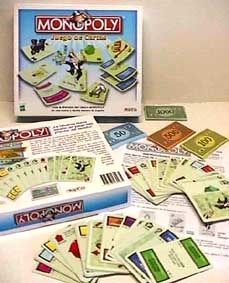 Edition: Monopoly - Juego de Cartas, Art.N° 3023 Edition: Monopoly - Juego de Cartas, Art.N° 3023
Publisher: Hasbro/Winning Moves/ToyCo -
2002
Dimensions of the box: 21.2 x 25.4 cm
The game:
The Monopoly card games issued since 2000 are designed by
Winning Moves and differ from the elder Happy Families.
This edition has 60 cards in total, of which:
 |
28 property cards |
 |
14 house cards ( 5x1. - 4x2. - 3x3. and 2x4.) |
 |
2 hotel cards |
 |
16 bonus cards |
For the rest are but 4 Monopoly banknotes in the denominations: 50
- 100 - 500
and 1000 $. There is no (little) game board,
however there are richly illustrated Rules:
The cards:
 |
Also with this edition 8 color groups of 2 or 3 cards have to be made with
the property deeds. The value of a complete group is given on the
cards. So applies for Avenida
Carolina del Norte: Valor del Set $350. |
 |
The value of a group is increased with house cards. One card always
counts for a whole groups. There are1st, 2nd, 3rd
and 4th house cards that must of course be purchased in this
order. The card of our example shows the additional value per house to be: cada casa suma $350
más. |
 |
Finally a hotel card can be added. Its value is for all groups $500. |
 |
De bonus cards are those of the tokens (6), Salida
(Start) (4), Mr. Monopoly (4) and Cartas
Suerte (2).
 |
The value of your token is identical to the sum of all complete groups
in your hand. |
 |
The Salida cards are worth $200. |
 |
Only the player possessing most of the Mr.Monopoly card at the end of
the game gets $1,000, the other cards do not have any further value. |
 |
Both Cartas Suerte can be used as Joker. They can replace other cards.
However ... watch out ...., this only applies to the first player to lay
down his cards. The other owner of a Joker loses all he has in hand. |
|
At the beginning of the match each player gets 10 cards he keeps in his hand.
An 11th card is led open on the table in front of him.
This is his first exchange card. In the course of the game it will be
joined by the unused cards from the take away stack. Each player can ask
another if he/she likes to exchange a number of cards from his stack for an
equal number of his own exchange stack. Both take these cards in hand and
put an equal number back on their stack in order to keep only 10 in hand.
The aim of the game is to become the first to have changed his cards into
complete groups with the right house and hotel cards and proper bonus cards in
such a way that he/she has the highest possible value in hand. Next the game is
repeated till one player becomes the first to reach a total amount of $ 10,000.
There are minor differences in the Rules for more or less than 4 players.
This edition was also exported to Chile and Peru.
The price of this set amounted to ARS 12.- (€ 3.60) July 2002.
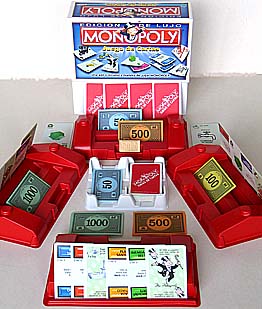 Edition: Monopoly - Juego de Cartas,
Art.N° 3032 Edition: Monopoly - Juego de Cartas,
Art.N° 3032
Edicion
de Lujo (Deluxe edition)
Una
ágil y dinámica manera de jugar Monopoly
(A flexible and dynamic way of playing Monopoly.)
Publisher: Hasbro/Winning Moves/ToyCo -
±2002
Dimensions of the box: 13.8 x 23.6 x 8.0 cm
The gamel:
Except for the fact that this Deluxe edition is smaller but in a higher box
there are a few more differences compared with Art.N° 3023:
 |
Except for the paper money there is a bar of gold,
worth $ 5,000, per player. |
 |
4 holders of
red plastic,
for the banknotes and cards of the players. |
 | To store the
banknotes and cards in the box there is an additional handy holder of white
plastic precisely fitting in the
red holder. |
The price op this game was in March 2003 ARS 17.90 (€ 5,40).
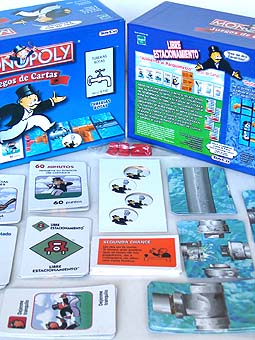 Edition: Monopoly - Juegos de Cartas, Art.N° 3022 Edition: Monopoly - Juegos de Cartas, Art.N° 3022
Libre Estacionamiento (Free Parking) -
Tuberias
Rotas (Leaking pipes)
Publisher: Hasbro/Winning Moves/ToyCo -
±2002
Dimensions of the box: 13.8 x 23.6 x 8.0 cm
The game:
In this box with the clear
red Monopoly bar,
a game is smuggled into the world of Monoply, that has nothing to do with it: Tuberias Rotas (Broken
pipes). As repairman of the pipes Mr. Monopoly is put into
action, who for this purpose had exchchanged his cane for a wrench this
time.
This game of the Leaking Pipes consists of:
 |
88 cards that
have to be distributed amongst the players. |
 |
8 circular,
cardboard discs showing the image of a wrench and
Mr. Monopoly. Each player will get 2 of these discs. |
The point of this
game is to construct as soon as possible a leakfree pipe.
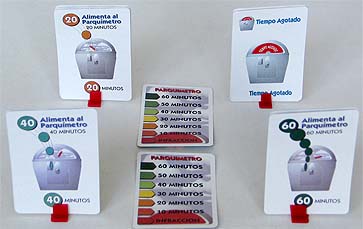 On
the back of a 50 cm long Rules paper is explained how to to play "Free
Parking". On
the back of a 50 cm long Rules paper is explained how to to play "Free
Parking".
It is to collect
points. The first player to collect 200 points is the winner. So in fact
this game as well is may not considered to be an Monopoly game, because it is
not about money.
In this game are:
 |
64 playing
cards, with which points have to be earned. However, there are cards that
oppose,
like: 2x Dejenme tranquilo (Leave me alone)
- 3x Tiempo Agotado (Time-out) -
2x Libre Estacionamiento en 2x Oficial Jones (the policeman). |
 |
4x Parking meter
cards and 4 red,
plastic feet, that altohether make the tokens. |
 |
32 "second
chance" cards. |
The price of this game amounted to ARS 17,50 (€ 5,25) in March 2003 .
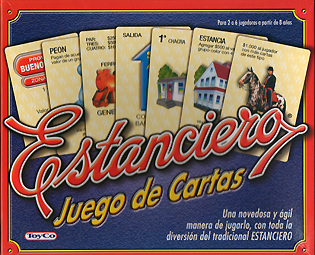 Edition: Estanciero
- Juego de Cartas, Art. N° 3036 Edition: Estanciero
- Juego de Cartas, Art. N° 3036
Publisher:
ToyCo
- Buenos Aires
- ±2002
Dimensions of the box: 21.2 x 25.3 x 4.1 cm cm
The game:
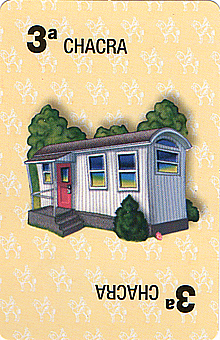 The
presentation of this first Estanciero looks very nice,
but there must have The
presentation of this first Estanciero looks very nice,
but there must have
been looked at the one from Winning Moves, see the game with Art.N° 3023.
Thus this game also has 60 playing cards, of which:
 |
28 property cards |
 | 14 Chacra cards ( 5x1. - 4x2. - 3x3. en 2x4.) |
 | 2 Estancia cards |
 | 16 "bonus" cards |
Furthermore there are only 4 Estanciero banknotes,
printed in black on colored paper
in the denominations: 50
- 100 - 500
and 1000 $. these little banknotes (dim.48x88 mm)
are also of the "Series
2002"as we already
met them in the Standard edition with Art.N° 9554.
There is no little game board, but a comprehensive illustrated, 4 page
sheet of Rules.
These correspond fully to those of the earlier mentioned game, where it should
be noted that all
property and other cards are of much nicer quality than those of Winning Moves.
On the bottom of the little box are nice images of banknotes and a
number of cards as well as the
salient text to promote a card game based on Monopoly:
La nueva versión del más popular de los entretenimientos de la familia
(The new version of the most popular family entertainment.)
Of course this edition was "Fabricado en Argentina".
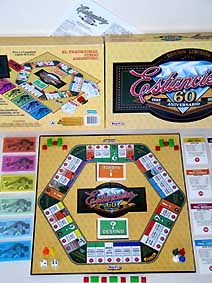 Edition: Estanciero
- 60 Aniversario - 1942-2002, Art.N° 9557 Edition: Estanciero
- 60 Aniversario - 1942-2002, Art.N° 9557
Publisher: ToyCo
- Buenos Aires - 2002
Dimensions of the box: 25.3 x 42.0 x
5.2 cm
Het spel:
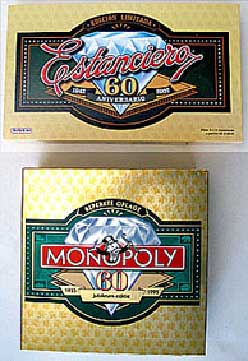 From this anniversary editiona few interesting things can be learned, like:
From this anniversary editiona few interesting things can be learned, like:
 |
The Estanciero started
in
1942, so 7 years after the official introduction of
Monopoly.
However it will probably not say ToyCo to be the publisher from
that year on?!
|
 |
There is a close
cooperation between
ToyCo and Parker/Hasbro, in view of for example
the image of the diamond on the empty board with the 5 "glittering
stars", the 60 that is
under the name with unther that the ribbon with the years.
|
 |
On all sides of the lid
both companies are shown with a diamond and the ribbon with the
text "Limited edition" in
the image.
|
The little
game board of this anniversary edition is smaller (38.5x38.8 cm) than
that of the standard edition (50.5x50.5 cm),but somewhat more colorful.The
distribution of the properties over the 6
sides is exactly the same as in
the game with Art.N°
9554 and again strikingly numbered from 1 through 41.
The bottom of the box shows again a nice color picture of the
board with the banknotes and all other accessories.
Although the spaces of the properties are small their property deeds are
the same size as those of the earlier publication, so 58x90 mm and with rounded
corners. The mortgage side is r ed.
The Estanciero-banknotes (48x88 mm) are those again publised by
the "Banco Estanciero Central", "Series:
2002".
The Chacras (homes) and Estancias (ranches)
are light
green
houses
and red hotels of hollow plastic.
The 6 plastic tokens
are the earlier mentioned simple pawns with large base again.
Both dice (with sides of 15 mm) are white with black pips.
The Rules are printed in black on white paper.
The
price of this set was in March 2003
ARS 29,90 (€ 9,-).
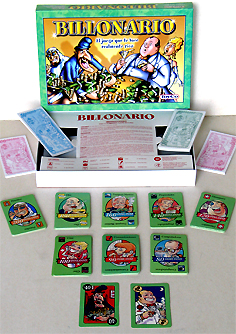 Edition:
Billonario (Billionaire) - Art.N° 9561 Edition:
Billonario (Billionaire) - Art.N° 9561
El
juego que te hace realmente rico. (This game really makes you
rich.)
Publisher: ToyCo S.R.L. - Buenos Aires - ± 2002
Dimensions of the box: 19.2 x 27.8 x 3.8 cm
The game:
Perhaps this game should not be considered to be a Monopoly-like game, but
because it is about acquiring "properties" and thus making money, I
still included it in the Monopoly Lexicon.
There are 8 groups of 8 cards each with a same value, namely:
 |
Petróleo
$ 200.000.000.- |
 |
Oro (Gold)
$ 180.000.000.- |
 | Transporte Maritimo (Shipping)
$
160.000.000.- |
 | Propiedades (Properties)
$ 140.000.000.- |
 |
Diamantes
$ 120.000.000.- |
 |
Cine
$ 100.000.000.- |
 |
Comunicaciones
$ 90.000.000.- |
 |
Computadoras
$ 80.000.000.- |
There are also two special cards, namely: the Tax Officer,
presented as "grabber" and the Billionaire, a wealthy man
with a big grin on his face.
The Tax Officer represents a deduction of $ 40.000.000at the end of the
game, while the Billionaire may be used as a groups' 8th card, or
dubling the value of an entire group either at the end of the game as a reward
of $
40.000.000.
The Rules are on the raised middle on the insert of the box.
On the bottom of the box is a picture of the happy family
playing this game (to the idea of Parker/Hasbro 1996.)
At the start of the game all cards are distributed to the
participants. If less than 8 players participate, just as many cardgroups have
to be distributed so: 5 players 5 card groups, starting with the most
expensive. Each player examines his cards and decide for which group he/she
intitially will go. This may change in the course of the game, depending on
the offer.
Once the banker has called "The market is open" the players
start to negociating. To this purpose they put their unwanted cards face down
in front of them (of course the Tax Officer will always be among them!). All
players can now have their unwanted cards exchanged for as many unseen cards
of another, hoping to get the missing cards as soon as possible for their own
group(s). The player who first has gathered a group of 8 equal cards
reports this and the banker will pay him the value of that group in
banknotes
The cards are collected, shuffled and distributed for the next round
The first one who has gathered $ 1.000.000.000 is the winner. (To shorten the
game a lower target amount can be agreed upon in advance.)
 Edition:
Los negosios del gran
GANADERO- Art. 903 (Negotiation
of the cattle-farm owner.) Edition:
Los negosios del gran
GANADERO- Art. 903 (Negotiation
of the cattle-farm owner.)
El clasico juego de compra venta de propiedades (The classic game
of buying and selling properties.)
Hacete millonario y divertite donde quierras (Become millionaire
and have fun everywhere.)
Publisher: Top
Toys - ± 2005
Dimensions of the box: 26 x 31x 7 cm
The game:
Although not announced as such this is clearly a travel edition,
because the board that is stuck in a brown
plastic box is only 19.5 x
19.5 cm. In the centre of the little board is a picture, as a background
image, of a ranche surrounded by corn fields. Over this is a rotary disc
to
serve as a die. Next to the little board are two lockable small boxes for the
small
(25x50 mm) cards, property deeds, banknotes, 5 tiny
little tokens, the 32 green Chacras (homes)
and 16 red Estancia (ranches).
On the overbox both "subtitels" are mentioned as well as a
very simplified presentation of a "rich ranger having fun".
There are only 9 spaces perside of the boardand the properties are Argentine
provinces.
The properties are from Salida onwards:
Misiones
- Suerte - Corrientes
- Entre Rios
- Estacion de Servicio Santa Fe - San Juan
- Paga impuesto 10% - San Luis -
Penitenciaria - Seguros Argentina - Santiago del Estero
- Tucuman - Destino - Chubut
- Santa Cruz - Bodegas Mendoza - Tierra
del Fuego - Vacaciones - Suerte - Jujuy
- Estacion de Servicio Rio Negro - Salta
- Soja La Pampa - Destino - Catamarca
- La Rioja - A la Penitenciaria - Suerte -
Chaco - Estacion de Servicio C.A. BS. AS.
- Formosa - Destino - Buenos
Aires and Cordoba.
The 5 tiny little tokens are: stirrup - butterfly
- Baco
- little whip and horse.
The Rules are on the bottum of the box.
The price of this game was in augustus 2006 ARS 27.90 (€9.-)
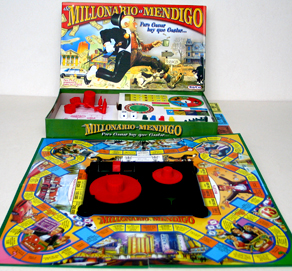 Edition:
de Millonario
a Mendigo Art.N° 9677 (From Miljonair to Beggar) Edition:
de Millonario
a Mendigo Art.N° 9677 (From Miljonair to Beggar)
Para Ganar hay que Gastar .... (To win you have to spend)
Publisherr: ToyCo S.R.L. - Buenos Aires - ± 2009
Dimensions of the box: 25.2 x 42.0 x 5.1 cm
The game:
Also
this
game
has
few
similarities
with Monopoly
and
is perhaps
more
comparable
with
Anti-Monopoly?
The
object
of
this game
is to
get rid of your one
million
as
quickly as
possible and
that seems not
so easy.
On the lid the world of a Millionaire
is symbolized
by
skyscrapers,
a
casino,
a $-stamp, a
limo
with
a
blonde
and
fluttering
U.S.
dollars,
while
that of
the
Beggar
of course
with
the
money box,
with an
albeit
large
but
empty
house,
where
two
large
signs
pointing
to "no
money"
and
"poverty",
where
a
dog
fights with
a
cat.
ToyCo's
relationship with
Parker
/
Hasbro
also
shows in this
game
again,
because
Mr.
Millionaire
is
very similar
to Mr. Monopoly
(hat
and
the
"straight
stick",
see the
World
Editions
from
2008.)
Furthermore,
there is once
again the
picture of
the
happy
family
on the
bottom
of the box
(to
the
idea
of
Parker
/
Hasbro
in
1996.)
Only four
players
can
join
the
game.They
each
have their
own
starting
point viz. the
corner to the
right
of
him
/
her.
At
that point the
player must also put his token (the champaign bottle
in the same color) and house at the start of the game.
It is played with:
 |
4 small banknotes (50x87 mm) in denominaties of
5.000
-
10.000
-
50.000
and
100.000. |
 |
3 kinds of international
shares (white biljetjes of 50x87 mm), namely: 3 x 10 pieces of
the
Cia. Eléctrica Relámpo (Electric Comp. "Thunderbolt"), 3 x 10
pieces of the Cia. Petrolera Torrente
Seco (Oil Comp. "Dry Source") and 3 x 10
pieces of the Cia. Aceros Grandote (Steel works "Enormous"). |
If
it's
your turn
move
your
bottle
the
number of the dice eyes
and
meet the
instruction
on
the field where
you arrive and:
 |
If
you have thown double 6
you have to pay the
bank
immediately 100,000
and
you may
throw
again. |
 | If
you
arrive on an
occupied
square,
you must
pay
10,000
for
damage to
the
opponent. |
 |
Every
time
you
come
across
the white field
Loteria
you have to put 5,000
on
the
silver plate (=
a
space
on
top the
field). |
How can you spend your money?
 |
By
investing
in
real
estate investments.
If
you
op
land on 1 of
6blue
"hotel
fields"
you can decide to pay the
price to the bank for
the hotel
shown
on that
field
and put your
(only)
hotel on that space.
The
lease to pay for
the hotel
is
mentioned on the
field. |
 |
On the Lotery-space.
If you land on the Loteria space you get all the money collected on
the silver scale. |
 | On
the corner spaces: Fair Game (Bolsa de Valores =
Equity Market), Racen (Hipodromo = race track),
Casino and gambling with dice (Timba de Dados =
Victems of the dice).
 |
If the
barrel swivel (symbolising the Fair) indicates that your shares lower
than the same applies to all shares. You have to pay the bank10.000. |
 |
Conversely:
if it is indicated that certain stocks rise then all owners of such
shares get 10.000 from the bank. |
 |
The
barrel swivel also has a blue
space with a $-sign. If that is listed first each player will receive
for each of his shares 10.000 "extra dividend" from the bank.
You can go public at any time, hoping your opponents can make money. |
 | If you are
going to participate in the Races
all players have to do so.
You choose one of the 4 horses shown on the dial, with horse 1 most
likely to win and horse 4 the lowest.The player after you will then get
the next horse on the dial, etc. Next each player indicates to the bank
for which amount between 5.000 through 50.000 he/she will bet. With one
turn of the dial is decided who the winner decided is.
The proceeds are as follows for the winning horse: Horse #1: 2x the bet-
Horse #2 3x the bet - 4x the bet - Horse #5x the bet. |
|
 |
In the Casino.
Here you play on 2 devices:
 |
The slotmachine:
You pay 20.000 and can run the slots 1 time. Yield: 1 pair of any kind: 50.000 - 1 trio
of sny kind: 150.000 and a trio of thr $-sign yields 250.000. |
 |
The Roulette:
Choose from the following 3 bets, pay the bank and give a cranck on the
wheel:
 |
Pay 5.000
and choose a single number
Then you can earn 150.000 |
 |
Pay 20.000
and choose a doden (1-12 / 13-24 / 25-36)
Then you can earn 100.000 |
 |
Pay 50.000
and choose red
or black
Then you can earn 80.000 |
|
|
 | Gamble with the dice: If it is your turn you may
throw the dice as many times as you like. Add all items together and
multiply by 5,000. This amount the bank will pay you.
However if you throw a one in a throw you should stop but still will receive
100,000. In case you thow double-1 then you should stop as well but receive
300,000. |
If you play the above Rules then you are the winner if the
first one who cannot pay his debts!
The price of this edition was
ARS 100 (€ 20,-). in april 2010.
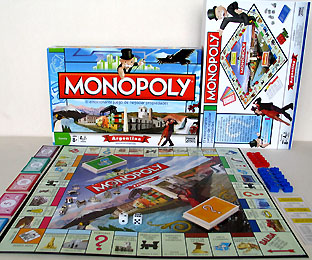 Edition:
Monopoly-Argentina -
Edicion de coleccion, Art.N° 0830 Edition:
Monopoly-Argentina -
Edicion de coleccion, Art.N° 0830
El emocionante juego de negociar propiedades
(The
exciting game of trading properties)
Publisher: Hasbro Int.Inc./Parker/The Toy Comp. S.R.L. -
2009
Dimensions of the box: 27.0 x 40.3 x 6.6 cm
The game:
Although the Editión-Argentina with Art.NN° 0820 was a slightly
"camouflaged" Hasbro edition (without the red
Monopoly bar), this edition of 8 years later clearly has all Hasbro features,
like:
 |
The red Monopoly bar, both on the lid
as sloping over the board's midfield, with Mr. Monoply with
silvery M
instead of a red bow tie and a new cane
on top the middle O instead of coming out of it. |
 |
This red bar also, but a bit smaller,
on all rims of the lid as well as on all rims of the innerbox. |
 |
The correct color bars on the right positions on the board. |
 |
The uniform global presentation of the box: sizes, the white
band on the lower part of the lid with
the "green-family-patch"
adjacent to the "age field" and "number of players"
field. |
 |
The richly illustrated bottom of the box, where at least will be shown: the
red
bar, an image of
the board with a number of attributes, a text field in a black frame,
a little bar showing the address of the Monopoly.com site and 1x an image of
the new Mr. Monopoly.
(There is however (yet) missing the statement of cooperation with EA.)
It is striking that on this issue the Parker logo is still appearing
frequently. |
The properties are now again toerist attractions of which there
are so many in this country. That is why it is so pity so many of them are the
same as in the game from 2001, although the fields on the board now have
pictures. The illustration on the board's midfield is the same as on the lid and
is a composition of the images from a.o. Cabildo de Buenos Aires - Casa
Historica de Tucuman - Aconcagua - Obelisco de Buenos Aires - Calle Caminito -
Cerro 7 colores - Pingüinera Punta Tombo and Glaciar Perito Moreno.
The solid game bord with black back is folded twice and in such a way
that the playfield is on the outside.
The properties are from Salida
onwards:
Plaza de los Dinosaurios - Arca Comunal - Valle de la Luna - Impuesto
sobre ingresos - Ferrocarril General Mitre - Cabildo
de Buenos Aires - Fortuna - Casa
Historica de Tucuman - Monumento a la
Bandera - Carcel - Puente del Inca
- Compañia de Electricidad - Aconcagua - Cristo
redentor (Mendoza) - Ferrocarril General Belgrano - Obelisco
de Buenos Aires - Arca Comunal - Cale
Caminito - Plaza de Mayo - Parada
libre - Basilica de Lujan - Fortuna - Villa Carlos Paz -
Mar
del Plata - Ferrocarril General - Cerro
7 colores - Cataratas
de Iguazu - Compañia de aguas Corrientes - Tren
de las Nubes - Vayase a la Carcel - Pingüinera
Punta Tombo - Faro del Fin del Mundo
- Arca Comunal - Peninsula Valdez - Ferrocarril General
Roca - Fortuna - Glaciar Perito Moreno
- Impuesto
sobre posesiones de de jujo and Hotel Llao-Llao.
 |
In the innerbox is a formed, blue
insert of soft cardboard with 1 tray for all attributes. |
 |
The front side of the property deeds (sizes: 60x90 mm) is white,
while their back is light blue and also
show a.o. the mortgage value. |
 |
The Arca Comunal and Fortuna
cards are also 60x90 mm and are richely illustrated with nice
images of Mr.Monopoly and his new cane! |
 |
The little banknotes do have the design of the original Parker
notes (with 2x a small rectangle in which the value is repeated, 1x a
rectangle with a house and 1x with a locomotive), but they are inly 49x87
mm. The values of the 7 notes of the "Banco Monopoly" are resp.: 1
- 5 - 10
- 20 - 50
- 100 en 500. |
 |
The hollow, plastic houses with chimney are red,
the hotels blue. They are still
attached to the casting rods. |
 |
The 8 metal tokens are glossy and are therefore clearly not from
the usual supplier. They
are: car - iron - wheelbarrow - hat - boat - dog - rider-on-rearing-horse
and canon. |
 |
Both dice are white with black pips. |
The price of this set amounted to ARS 129,- (€ 26,-) April 2010.
|